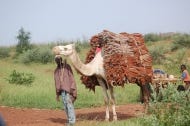Prices of all commodities, particularly sugar, declined in January.

The FAO Food Price Index fell in January, slipping 1.9% below its level in the last month of 2015 as prices for all of the commodities it tracks fell, particularly for sugar.
The Food Price Index averaged 150.4 points in January, down 16% from a year earlier and registering its lowest level since April 2009. The main factors underlying the lingering decline in basic food commodity prices are the generally ample agricultural supply conditions, a slowing global economy and the strengthening U.S. dollar, FAO noted.
This month, FAO also raised its forecast for worldwide cereal stocks in 2016 as a result of lower projected consumption and higher 2015 production prospects.

A farmer in Niger takes his sorghum to market. Source: FAO
The Dairy Price Index dropped 3.0% on the back of large supplies in both the European Union and New Zealand and torpid world import demand.
The Cereal Price Index declined 1.7% (to 149.1 points) amid ample global supplies and increased competition for export markets, especially for wheat and maize, as well as a strong U.S. dollar.
The Meat Price Index moved 1.1% lower than its revised December value, with prices for all meat categories falling except for pork, which FAO said was sustained by the opening of private storage aid in the EU.
The Sugar Price Index fell 4.1% from December, its first drop in four months, as crop conditions improved in Brazil — by far the world's leading sugar producer and exporter.
Mixed early prospects for 2016 harvests
Weather patterns associated with El Nino are sending mixed signals about the early prospects for cereal crops in 2016, especially in the Southern Hemisphere, according to FAO's recently released “Cereal Supply & Demand Brief.”
The crop prospects for 2016 have been "severely weakened" in southern Africa, and a 25% cut in wheat production in South Africa now appears likely. Conditions for the crop are generally favorable in Russia and the EU, but winter plantings declined in the U.S. and Ukraine, the report notes.
The area in wheat is also expected to be cut in India following a poor monsoon and below-average rains since October.
The 2016 outlook for rice along and south of the Equator is "dim" due to insufficient water at times and excessive rains at other times.
As for the 2015 season, FAO modestly raised its forecast for world cereal production to 2,531 million metric tons, a slight increase from December. FAO said wheat output in Canada and Russia and maize output in China, Canada and Paraguay drove the upward revision. FAO also slightly raised its expectation regarding 2015 world rice production, mostly on account of higher forecasts for China, Vietnam and the U.S.
At the same time, FAO lowered its forecast for world cereal utilization in the 2015-16 season to 2,527 mmt, which remains 0.8% above the previous year. According to FAO, this reflects a 2.0% increase for wheat, largely because of higher livestock feed use in developed countries and a 0.3% increase in maize. World rice utilization is projected to expand by 1.1%, keeping world per capita consumption stable.
As a result of the upgraded production and downgraded consumption forecasts, world cereal stocks are set to end the 2016 seasons at 642 mmt — higher than they began. That level implies a steady and comfortable global cereal stock-to-use ratio of around 25%, FAO noted.
However, the inventory buildup varies both geographically and by crop. FAO said notable increases in wheat inventories are expected for the U.S., EU and China but added that some reductions are likely in Canada, India and the Islamic Republic of Iran. On the other hand, world rice stocks would need to be drawn down to bridge the expected gap between world production and consumption, with much of the release likely to concern India and Thailand, the two leading rice exporters, FAO said.
About the Author(s)
You May Also Like

.png?width=300&auto=webp&quality=80&disable=upscale)

